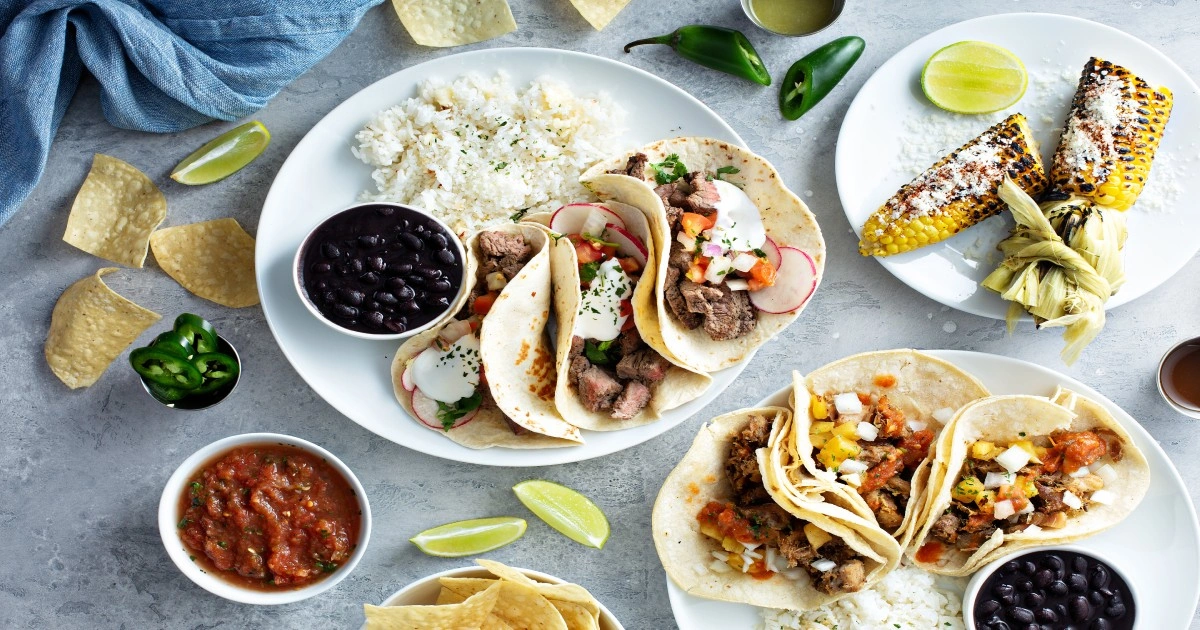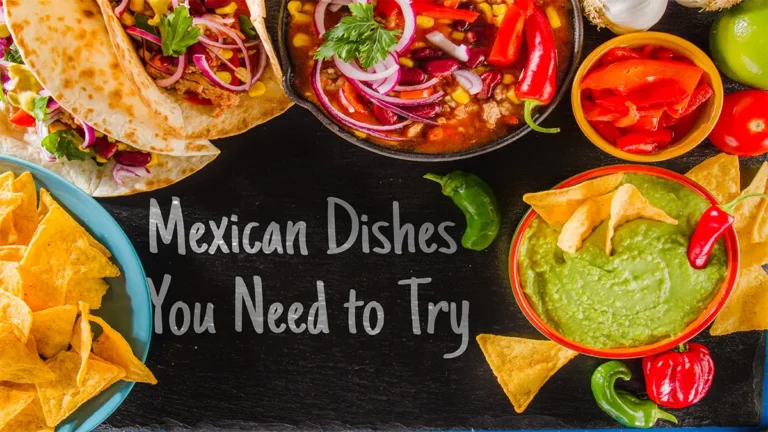10 Best Mexican Dishes to Try When Visiting Mexico
When you visit Mexico, you’re in for a culinary adventure. The country is known for serving some of the best Mexican dishes in the world. From bold street food to rich traditional meals, authentic Mexican cuisine offers unforgettable flavors rooted in culture and history.

From spicy tacos to savory mole, top Mexican recipes show the country’s history and culture. You can explore different regions. Each has its own twist on traditional best Mexican dishes.
Key Takeaways
- Discover the rich flavors of authentic Mexican cuisine.
- Explore top Mexican recipes that reflect the country’s history.
- Try the best Mexican dishes during your visit.
- Experience the diversity of Mexican culinary landscape.
- Enjoy the unique regional twists on traditional dishes.
Discovering the Rich Flavors of Authentic Mexican Cuisine
Exploring Mexican cuisine reveals how food is central to the country’s culture. It’s a mix of indigenous, European, and African influences. This blend creates a unique taste that shows Mexico’s history and traditions.

The Cultural Significance of Food in Mexico
In Mexico, food is more than just food; it’s a sign of welcome, community, and pride. Traditional dishes are key in family events and celebrations. Sharing meals strengthens family ties and keeps traditions alive.
Try a traditional Mexican meal to see this for yourself. You’ll enjoy a variety of traditional Mexican favorites.
Regional Variations in Mexican Cooking
Mexico’s vastness means each area has its own authentic Mexican cuisine twist. The Yucatán uses citrus and spices, while the north is known for bold flavors. Oaxaca is famous for its moles, and coastal areas have fresh seafood.
Traveling Mexico, you’ll find many regional dishes. This shows the country’s culinary diversity. Whether in Mexico City or a small village, you’ll see the deep roots of Mexican cuisine in its traditions.
Tacos al Pastor: Mexico’s Iconic Street Food
Tacos al Pastor is a favorite in Mexico’s street food scene. It’s a mix of Mexican and Lebanese flavors. This dish is loved by both locals and visitors.
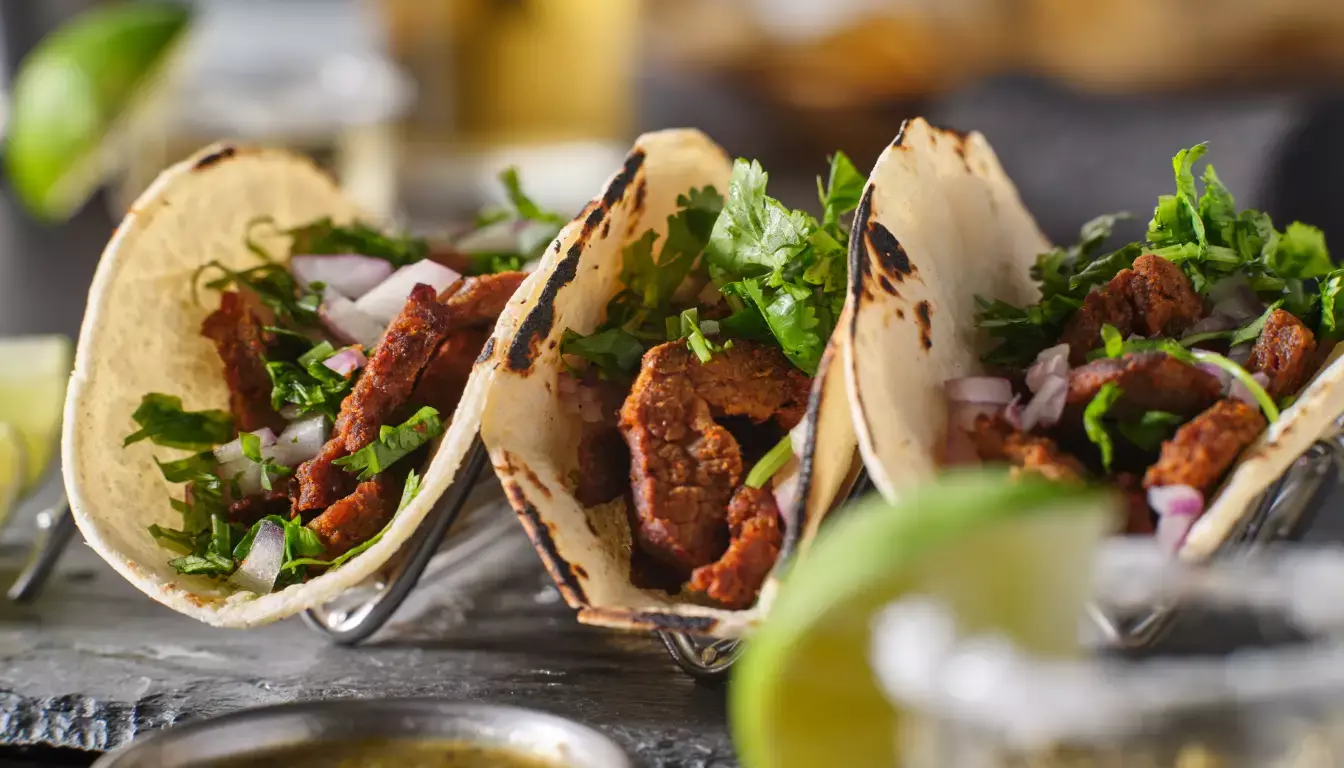
The story of Tacos al Pastor is interesting. Lebanese immigrants came to Mexico in the early 1900s. They brought their cooking ways, like cooking meat on a vertical spit.
The Lebanese Influence on This Beloved Dish
The name “al Pastor” means “shepherd style.” It shows the dish’s link to Middle Eastern shawarma. Instead of lamb or chicken, it uses pork.
The marinade for Tacos al Pastor has spices, chilies, and pineapple. This mix gives the dish its unique taste. The cooking method makes the meat tender and full of flavor.
Key Ingredients and Preparation Methods
Here’s what makes Tacos al Pastor special:
- Pork shoulder or loin, marinated in a mix of chilies, spices, and pineapple
- Cooking the pork on a vertical spit, called a trompo
- Slicing the pork into thin strips
- Serving the pork in a corn tortilla, with pineapple, onion, and cilantro
The way Tacos al Pastor is made is key to its taste. The vertical spit cooks the meat evenly. The marinade adds a rich flavor.
Where to Find the Best Tacos al Pastor in Mexico City
Mexico City is famous for its street food, including Tacos al Pastor. Here are some top places to try it:
- La Taqueria: Known for its authentic and tasty Tacos al Pastor.
- Tacos el Gordo: A local favorite with years of serving great Tacos al Pastor.
- Los Tacos No. 1: A busy taqueria with many tacos, including amazing Tacos al Pastor.
Visiting these places lets you experience Mexico’s street food culture. You’ll get to enjoy some of the city’s best Tacos al Pastor.
Mole Poblano: The National Dish of Mexico
Mole Poblano is a dish that stands out in Mexican cuisine. It’s rich in history and flavor. This shows the country’s diverse culinary and cultural heritage.
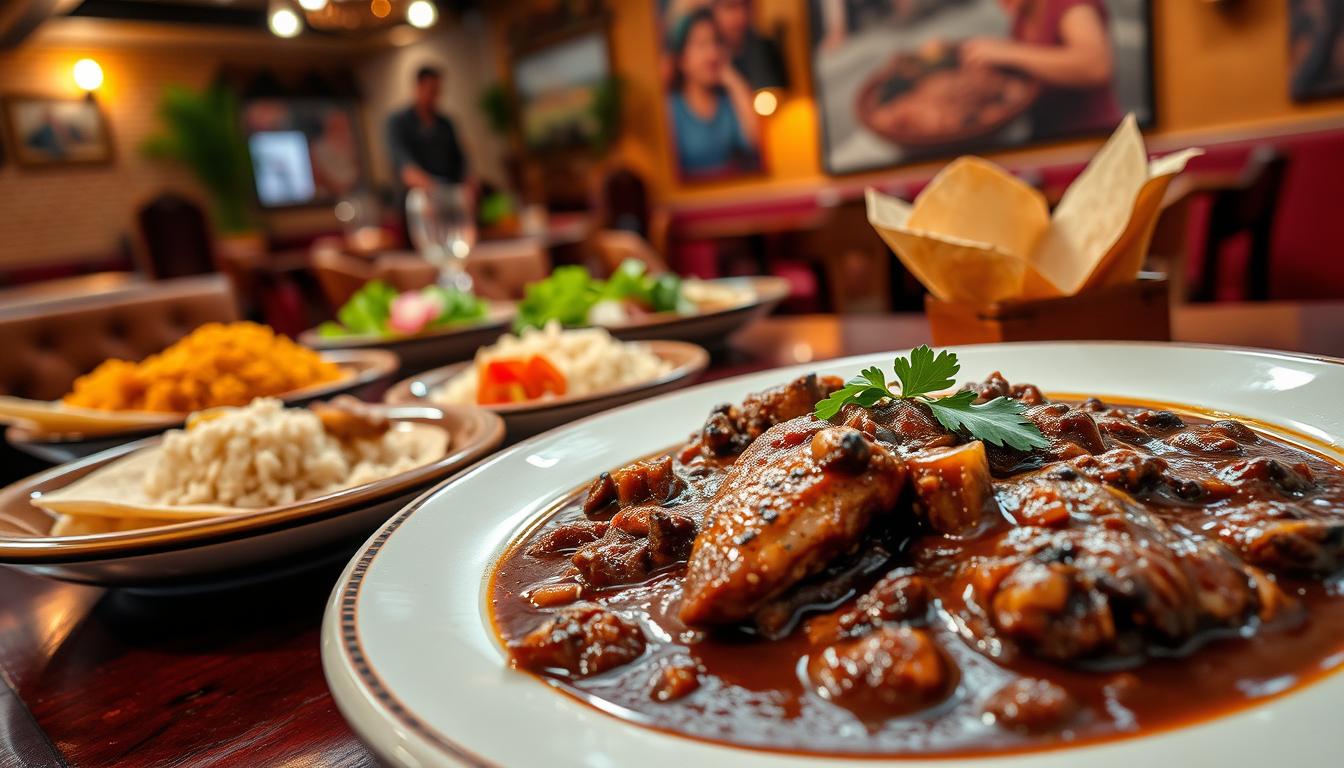
The Complex Blend of Ingredients in Traditional Mole
Mole Poblano has a mix of chocolate, spices, nuts, and chil peppers. This mix makes a sauce that’s both savory and sweet. Making Mole Poblano is hard work, as ingredients are roasted and ground to get the right flavor.
The use of chocolate in Mole Poblano might seem odd. But it adds depth and a slight bitterness. This balances the dish. The spices and nuts make it a true authentic Mexican cuisine experience.
Regional Variations of Mole Throughout Mexico
Mole Poblano is a big deal in Puebla, but Mexico has many mole variations. Each place adds its own twist with local ingredients and methods. For example, some places might use different chilies or skip some ingredients.
Yet, Mole Poblano is a standout, showing the heart of famous Mexican dishes. It’s loved worldwide, with many restaurants trying to make this authentic Mexican recipe.
Best Restaurants to Experience Mole in Puebla
Puebla is the best place to try Mole Poblano. Many top restaurants in the city serve this dish, with both traditional and new takes.
- La Casa de las Enchiladas: Known for its traditional Mole Poblano recipe.
- El Mural de los Pueblos: Offers a modern twist on the classic dish.
- La Morada: Provides an immersive culinary experience with its rich, flavorful Mole.
Going to these places is a great way to enjoy top Mexican recipes. You’ll see why Mole Poblano is a national treasure.
Chiles en Nogada: A Patriotic Culinary Masterpiece
For a true Mexican experience, try Chiles en Nogada. It’s a dish that celebrates Mexico’s heritage. It’s not just tasty but also a symbol of national pride.

The History Behind This Colorful Dish
Chiles en dates back to the early 19th century. It was made to honor Agustín de Iturbide, Mexico’s first Emperor. The Puebla nuns created it to celebrate the country’s independence and its rich food traditions.
This dish is more than just food. It’s a journey through Mexico’s history.
The Symbolism of the Mexican Flag Colors
The dish’s colors – green, white, and red – mirror the Mexican flag. The poblano peppers are green, the sauce is white, and the pomegranate seeds are red. These colors represent Mexico’s unity and national pride.
This patriotic culinary masterpiece is a must-try, often around Mexico’s Independence Day.
Seasonal Availability and Where to Try It
Chiles en Nogada is available from late summer to early fall. This is when pomegranates are in season. To taste it, visit Puebla, where it was born. Many local spots in Puebla serve authentic Chiles en Nogada.
In Puebla, seek out restaurants known for their traditional dishes. The fresh, local ingredients will make your Chiles en Nogada experience unforgettable.
Pozole: The Ancient Ceremonial Stew
Exploring Mexico’s culinary world, you’ll find Pozole, a traditional stew. It’s been a key part of Mexican food for centuries, starting with the Aztecs. This stew shows Mexico’s rich food history and its varied tastes.
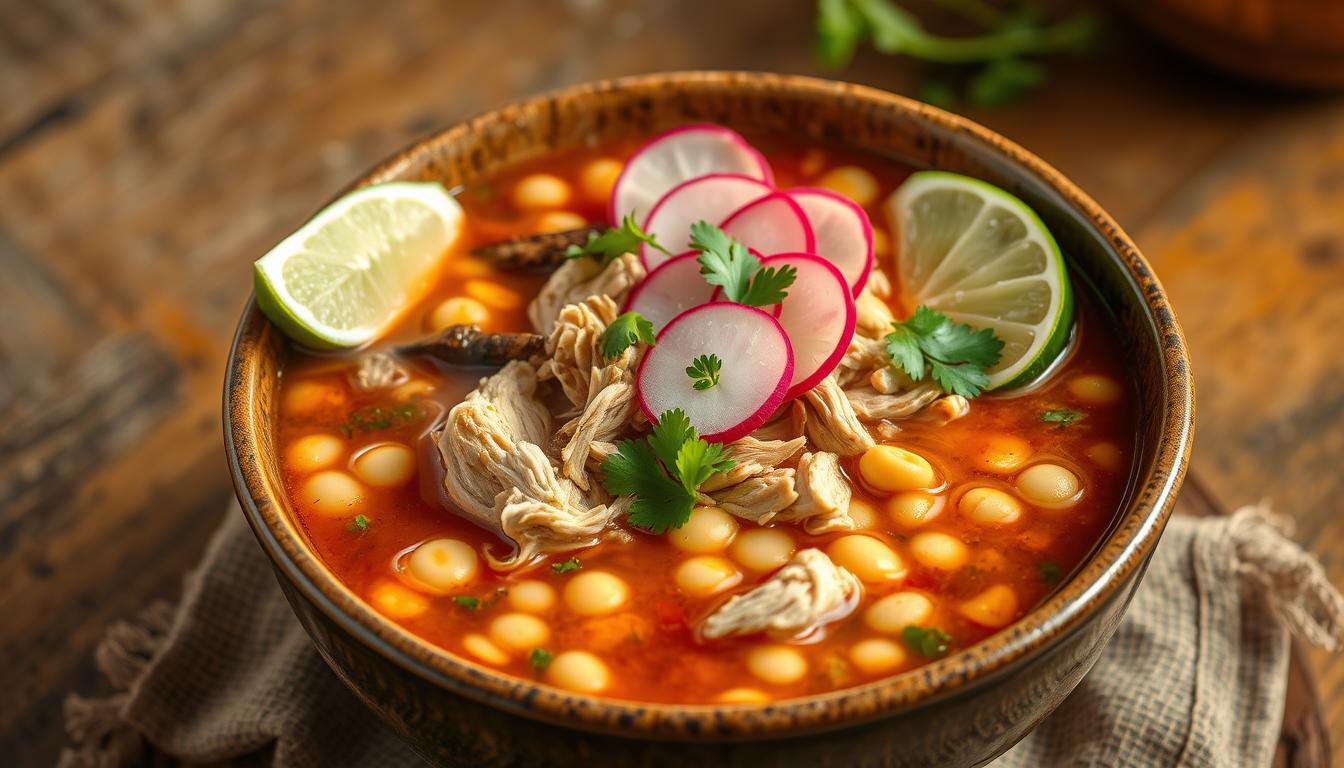
Red, White, and Green Varieties of Pozole
Pozole has three main types: red, white, and green. Red Pozole has a spicy broth from chilies. White Pozole has a clear broth and soft hominy. Green Pozole is special with pumpkin seeds and cilantro.
Traditional Garnishes and Accompaniments
Enjoying Pozole means adding your favorite toppings. You can use shredded cabbage, radishes, lime wedges, and tortilla chips. These add flavor and let you make your Pozole just right.
The Cultural Significance of Pozole in Mexican Celebrations
Pozole is big in Mexican celebrations. It’s served at special times, showing unity and community. Sharing Pozole brings people together, highlighting food’s role in Mexican culture.
In short, Pozole is more than food; it’s a way to connect with Mexico’s heritage and flavorful Mexican cooking. Whether at a market or a family event, Pozole is a standout best Mexican dish.
Cochinita Pibil: The Yucatán’s Slow-Roasted Pork Delicacy
Exploring Mexico’s flavors isn’t complete without trying Cochinita Pibil. This dish from the Yucatán is a blend of rich tastes and ancient cooking ways.
Ancient Cooking Techniques Preserved in Modern Times
Cochinita Pibil uses old Mayan cooking methods. The pork is marinated in spices and sour orange juice. Then, it’s slow-roasted in a pib until it’s tender.
This method makes the meat juicy and full of flavor. It’s a dish that’s both tender and delicious.

The traditional way to cook it is by wrapping the pork in banana leaves. It’s steamed in the pib. This keeps the meat moist and the flavors together.
Today, people also use ovens or slow cookers. But the dish’s essence stays the same.
The Essential Role of Achiote and Sour Orange
Achiote and sour orange are key to Cochinita Pibil. Achiote gives it a red color and a sweet, earthy taste. Sour orange adds a tangy, citrusy flavor.
Together, they make a dish with a unique flavor. This mix of achiote and sour orange makes Cochinita Pibil stand out.
Where to Find Authentic Cochinita Pibil in the Yucatán Peninsula
To try authentic Cochinita Pibil, visit local spots in the Yucatán. In Mérida, the capital, you’ll find great versions at traditional restaurants and street food stalls. Look for places that use traditional methods and ingredients.
Recommended spots include Mérida’s markets and taquerias in Tulum and Playa del Carmen. These places offer a true taste of Cochinita Pibil, a traditional Mexican favorite.
Enchiladas: Beyond the Tex-Mex Version
Mexican enchiladas show the country’s rich food diversity. Each region has its own enchilada style. This dish is more than food; it’s a window into Mexico’s culture.
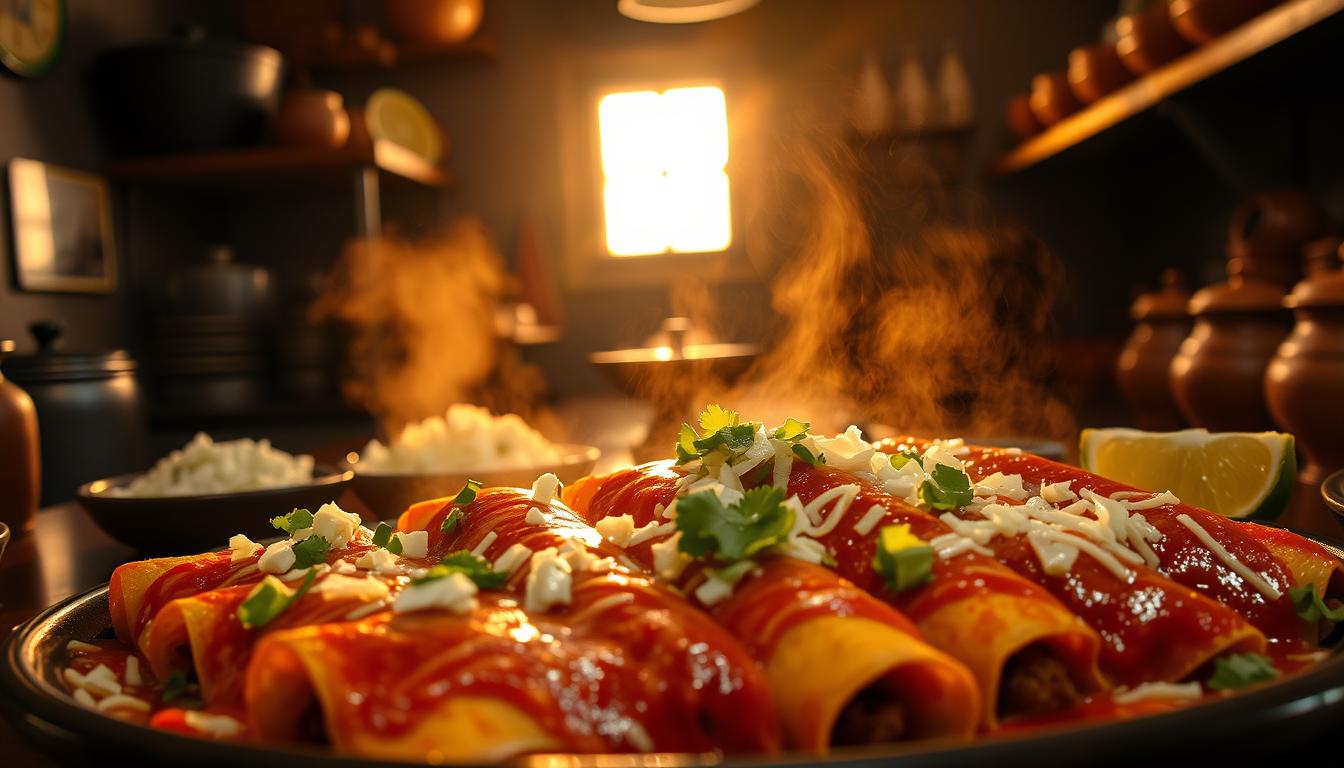
The True Origins of Authentic Mexican Enchiladas
Enchiladas have a long history, dating back to the Aztecs and Mayans. They used tortillas as a main food. The word “enchilada” comes from “enchilar,” meaning “to season with chili peppers.”
This tradition of wrapping tortillas in chili sauce has grown. It’s shaped by local ingredients and cooking methods.
Regional Variations Across Different Mexican States
Traveling through Mexico, you’ll find many enchilada styles. Each one shows the local tastes and traditions. For example, central Mexico has Enchiladas Rojas with a tangy tomato sauce.
In the Yucatán, you’ll find Enchiladas Verdes with a green tomatillo sauce. Every region has its own enchilada twist.
Must-Try Enchilada Styles: Suizas, Potosinas, and Mineras
Some top enchilada styles include:
- Enchiladas Suizas, known for their creamy tomatillo sauce and tender chicken.
- Enchiladas Potosinas, from San Luis Potosí, with thick tortillas filled with cheese or meat.
- Enchiladas Mineras, a hearty dish from mining regions, with rich sauce and various fillings.
Trying these enchilada styles will deepen your love for delicious Mexican food. Whether it’s a casual meal or a special event, enchiladas are a must-try Mexican meal. They highlight the best of authentic Mexican cuisine.
The Best Mexican Dishes Found in Traditional Markets
Traditional Mexican markets are full of flavors. They are places where you can find some of Mexico’s favorite dishes. These markets are alive with color and smell, filled with fresh produce and handmade tortillas.
Chiles Rellenos: Stuffed Peppers with a Mexican Twist
In these markets, you’ll find Chiles Rellenos. It’s a mix of roasted poblano peppers stuffed with cheese, then battered and fried. It’s often served with tomato sauce and can have different fillings like meats and veggies.
Making Chiles Rellenos is an art. It needs careful pepper selection and a gentle touch when stuffing and frying. This dish is a true taste of Mexican cooking, showing its variety and richness.
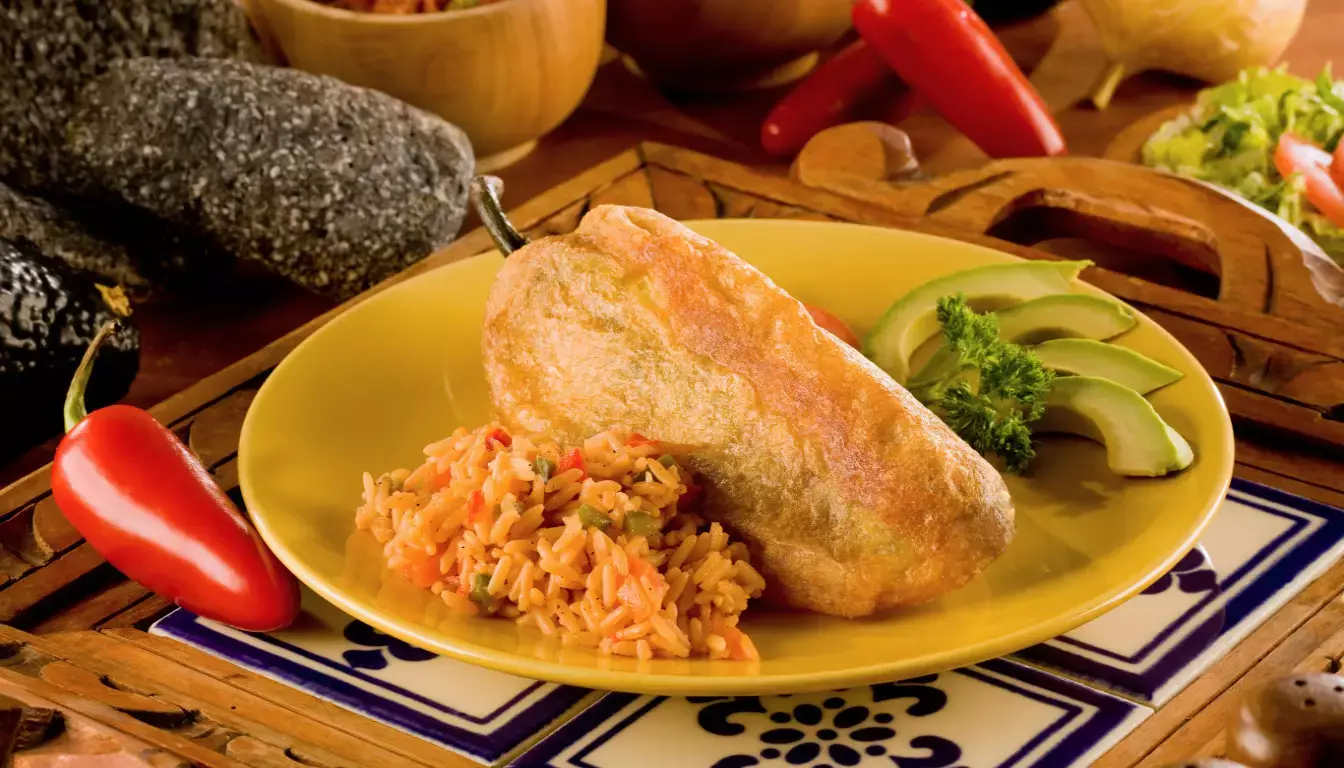
Tlayudas: Oaxaca’s “Mexican Pizza”
Tlayudas, known as “Mexican pizza,” is another favorite. It comes from Oaxaca and is a big, crispy tortilla topped with beans, cheese, meats, and cilantro.
Tlayudas stand out because of their crunchy texture and rich flavors. They show the creativity and resourcefulness of Mexican street food.
Navigating Food Markets for Authentic Culinary Experiences
To enjoy your visit to a traditional Mexican market, here are some tips:
- Be adventurous and try new dishes.
- Engage with vendors to learn about the ingredients and preparation methods.
- Come hungry and be prepared to try a variety of flavors.
- Don’t be afraid to ask for recommendations from locals.
By following these tips, you’ll have a rich and authentic culinary experience. It will give you lasting memories of your time in Mexico’s traditional markets.
Coastal Treasures: Mexican Seafood Specialties
Mexico’s coastal cuisine is filled with flavors, with seafood being a big star. As you travel through the country’s coastal areas, you’ll find many seafood dishes. These dishes show off the freshness and richness of Mexican food.
Raw Delights: Ceviche and Aguachile
Ceviche and Aguachile are seafood dishes loved around the world. Ceviche is made with fresh fish marinated in lime juice. It’s mixed with onions, cilantro, and chili peppers, making it tangy and refreshing. Aguachile is raw shrimp marinated in lime juice, chili peppers, and seasonings. It has a spicy kick.
Both dishes are simple yet full of flavor. They use the freshest ingredients to make healthy and tasty dishes.

Pescado a la Veracruzana: A Flavorful Tradition
Pescado a la Veracruzana comes from the Gulf Coast, mainly from Veracruz. It’s a fish dish cooked in a tomato sauce with olives, capers, and spices. This creates a rich and savory taste. The dish is known for its fresh fish and unique flavors.
Best Coastal Regions for Seafood Enthuasiasts
Mexico’s long coastline is perfect for seafood lovers. There are many regions to explore:
- The Gulf Coast is famous for its seafood traditions and dishes like Pescado a la Veracruzana.
- The Yucatán Peninsula is known for seafood dishes influenced by Mayan cuisine.
- The Pacific Coast offers a wide variety of seafood, from fish to shellfish.
Visiting these areas will help you appreciate the variety and richness of Mexican seafood.
Traditional Mexican Desserts You Can’t Miss
Exploring Mexican cuisine reveals a world of traditional desserts that will delight your taste buds. These sweets reflect Mexico’s rich cultural heritage. They blend indigenous, Spanish, and international influences into a unique culinary identity.
Churros, Flan, and Tres Leches Cake
Mexican desserts are famous for their rich flavors and textures. Favorites include churros, flan, and Tres Leches Cake. Churros are fried dough pastries coated in cinnamon sugar, served with chocolate or cajeta for dipping.
Flan is a creamy custard dessert, a staple in Mexican cuisine. It offers a smooth and comforting taste. Tres Leches Cake is a moist sponge cake soaked in three types of milk. This creates a dessert that’s both decadent and refreshing.
Regional Sweet Treats from Around Mexico
Mexico’s diverse regions have their own unique desserts. These reflect local ingredients and traditions. For example, alegrías are a sweet treat made from amaranth seeds and honey, from indigenous communities.
In the Yucatán, you might enjoy brazo de gitano, a rolled sponge cake filled with custard or jam. These regional desserts showcase the variety of Mexican sweets. They also tell stories of the country’s history and cultural diversity.
Mexican Chocolate and Its Ceremonial Importance
Mexican chocolate has a rich history and cultural significance. Originally consumed by the Mayans and Aztecs, it was a luxury item. Today, it’s known for its distinct flavor, often including spices like cinnamon and nutmeg.
It’s used in desserts and traditional drinks like hot chocolate. This beverage is a comforting and rich treat enjoyed throughout Mexico.
Exploring traditional Mexican desserts is a journey through the country’s culinary heritage. It offers a taste of its history, culture, and the warmth of its people. Whether you’re trying a classic dessert or a regional specialty, Mexican sweets will leave a lasting impression.
Navigating Dietary Restrictions While Enjoying the Best Mexican Dishes
Exploring Mexico’s rich flavors doesn’t mean you have to skip your dietary needs. More and more Mexican restaurants now offer a variety of options for different diets.
Vegetarian and Vegan Options in Traditional Mexican Cuisine
Traditional Mexican food is full of vegetarian and vegan choices. You can enjoy dishes like chiles rellenos (stuffed peppers) and tlayudas (Oaxacan “pizza”) without animal products. Many places now clearly mark these options, making it simpler to pick what you like.
- Tacos de flor de calabacín (zucchini flower tacos) are a favorite in Mexico.
- Ensalada de nopal (cactus salad) is a light and healthy choice.
- Vegan migas (a dish made with bread) can be found in some areas.
Gluten-Free Mexican Specialties
Mexican food often includes gluten-free options. Corn-based dishes like tacos, tamales, and pozole are naturally gluten-free. But, it’s important to tell the restaurant staff about your dietary needs to avoid any mix-ups.
- Choose corn tortillas over flour ones.
- Go for dishes with fresh ingredients and avoid processed meats.
- Make sure to ask if the dish is gluten-free.
Communicating Dietary Needs in Mexican Restaurants
Talking about your dietary needs in Mexico is easy if you know a few phrases. Saying “¿Este plato es vegetariano/vegano/gluten-free?” (Is this dish vegetarian/vegan/gluten-free?) can be very helpful.
In tourist spots, many restaurants have staff who speak English. But, learning basic Spanish phrases about your diet is a good idea. Always ask your server about the ingredients and how dishes are made.
Conclusion: Embracing the Full Spectrum of Mexican Gastronomy
Exploring Mexican cuisine opens up a world of flavors and traditions. You’ll find best Mexican dishes like Tacos al Pastor and Mole Poblano. Each dish reflects Mexico’s rich cultural heritage.
Enjoying authentic Mexican cuisine in local spots or traditional Mexican favorites at family events is special. Famous Mexican dishes like Chiles en Nogada and Cochinita Pibil are not just tasty. They also share Mexico’s history and regional differences.
Every meal in Mexico is a chance to connect with local culture and traditions. So, be bold, try new things, and dive into the rich world of Mexican food.
Ready to dive deeper into Mexico’s rich heritage?
Explore authentic traditions, vibrant festivals, and cultural treasures that make Mexico truly extraordinary!
Discover Culture & TraditionsFAQ
What are the must-try Mexican dishes when visiting Mexico?
Don’t miss out on Tacos al Pastor, Mole Poblano, and Chiles en Nogada. Also, try Pozole, Cochinita Pibil, and Enchiladas. These dishes highlight Mexico’s rich culinary heritage.
What is the cultural significance of food in Mexico?
Food is deeply rooted in Mexican culture. It reflects the country’s history, traditions, and regional identities. Trying authentic Mexican cuisine is a great way to experience this.
Are there vegetarian and vegan options in traditional Mexican cuisine?
Yes, there are many vegetarian and vegan options. Look for dishes with roasted vegetables, beans, and corn. You can also ask for gluten-free options.
How do I communicate my dietary needs in Mexican restaurants?
Let your server know about your dietary restrictions. They will help you choose from the menu. Many restaurants in Mexico are welcoming to visitors with special dietary needs.
What are some popular Mexican desserts I should try?
Try Churros, Flan, and Tres Leches Cake. Don’t forget to taste regional sweet treats. Mexican chocolate is also a must-try for its rich flavor.
Where can I find the best Tacos al Pastor in Mexico City?
For the best Tacos al Pastor, visit street food stalls or restaurants in La Condesa or Roma. These areas are known for their delicious offerings.
What are some must-try Enchilada styles?
You should try Suizas, Potosinas, and Mineras Enchiladas. These styles are among the most flavorful and traditional in Mexican cuisine.
🌮 Authentic Mexican Restaurants
Discover the best local food spots in Mexico’s most vibrant cities

